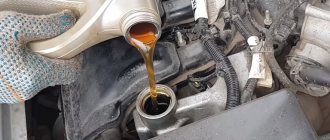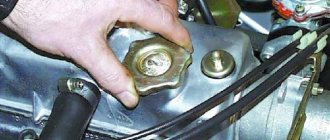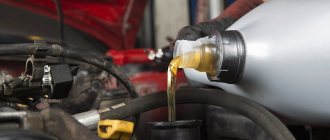Lada Vesta is the flagship car of AvtoVAZ, as well as the most modern Russian car today. Produced since the end of 2015. In addition to the sedan of the same name, a station wagon and a cross-version are also produced based on Vesta. The closest competitors are Volkswagen Polo, Hyundai Solaris and Renault Logan. The car is available with gasoline engines of 1.6 and 1.8 liters, with a power of 100 and 122 hp. With. respectively. Gearboxes - 5-speed manual or robotic gearbox, offered only for the 1.8 engine. In 2022, sales of Vesta began with a 1.8-liter engine, boosted to 144 hp. With. This car is considered the most expensive in the history of AvtoVAZ.
How often do you need to change the oil in automatic and manual transmissions of Vesta?
The lubricant in the units must be changed in accordance with the replacement schedule. The manufacturer has set the oil change service interval for manual transmissions as follows:
- TO-0. After 1000-3000 kilometers. At this stage, the car owner must make the first oil change in order to clear it of the effects of break-in. During the running-in process, parts are ground in, resulting in the inevitable formation of chips. It is this that needs to be cleaned from the box when changing the oil.
- TO-4. It comes after 40 thousand kilometers. This interval is normal and in the future the driver should change the oil exactly at this frequency.
In addition to manual transmission, Lada Vesta is equipped with an automatic transmission. Initially, it was an unsuccessful robot, but then it was replaced by the Japanese Jatco CVT.
The manufacturer claims that the transmission fluid is poured into it for its entire service life - 3 years or 100 thousand kilometers, but in fact, car mileages in Russia are much longer, and therefore an oil change for this unit is inevitable.
Throughout the entire 100 thousand kilometers, the fluid must be monitored during maintenance. Specialists check the level and quality of the oil. If it does not meet the standards, has a dark color or a burning smell, then it must be replaced. This can happen at any time, depending on the operating mode.
The general recommendation for all owners is to change the oil in an automatic transmission in the same way as in a manual transmission - once every 40 thousand kilometers.
What you will need
Changing the oil in an AMT Lada Vesta, as well as in a manual transmission, comes down to a simple principle - drain the old one and fill it with fresh one. In addition to the prepared oil, you will need the following:
- a set of keys;
- slotted screwdriver;
- container for old liquid (at least 2.5 liters);
- 20 mm hose and funnel.
In order for the oil to drain better, it needs to be warmed up. To do this, it is enough to drive 5-10 km.
What kind of oil should be poured into the Vesta box?
If we talk about the Japanese CVT, then there is no choice. The manufacturer strongly recommends pouring only original NS3 Fluid Nissan fluid. The use of conventional gear oils in this box is not permissible.
As for mechanics, in this case the choice is wider and the car owner can use anything as long as it meets the GL-4 and GL-4+ standard. If you have difficulty choosing, you can choose from the following brands:
- Lukoil TM-4 75W90;
- ZIC GFT 75W85 GL-4;
- Elf Tranself 75W85;
- UAZ TM4 GL-4 75W85.
Oil under the UAZ brand has a lot of positive reviews. Car owners note easy gear shifting and lack of noise when driving. But Lukoil is the best option in terms of price-quality ratio; it is also the choice of the manufacturer.
Factory oil
The Lada Vesta, produced by AvtoVAZ from the factory, is filled with transmission fluid TM 4-12 Tatneft Translux 75w85 API GL-4. This is a semi-synthetic liquid that operates in a wide temperature range - from -40 to +45 degrees, which is optimal for Russia. If you plan to change the lubricant, then it is advisable to do this not immediately, but not after 100 km. It is better to change the gearbox oil after the car has driven 4 or 5 kilometers.
The planned replacement of lubricant in the VAZ-21807 gearbox, as well as in the AMT, is due after 75,000, with aggressive driving after 35,000.
Is it necessary to flush the Lada Vesta gearbox?
If you follow all the rules for operating the car, flushing the Lada Vesta gearbox will not be required. This procedure may only be required in the following cases:
- After running in the gearbox. You can remove the effects of break-in by simply replacing the lubricant. But if you do additional flushing, the crankcase will be much cleaner and, if not 100%, then 90% clear of old oil and chips.
- It is also a good idea to flush when changing the brand of engine oil. The fact is that different manufacturers use their own set of additives, which can enter into a chemical reaction with additives in other brands of oils. The result of this reaction is a residue that interferes with the normal functioning of the lubricant.
- The last and most appropriate use for flushing is the accidental use of counterfeit oil. If unsuitable or low-quality oil was poured into the box, flushing may be required.
You cannot use aggressive washes again. The fact is that they lift old dirt from the parts, which is not removed through the drain plug.
As a result, contamination or deposits, which could have stood in one place until the transmission was repaired, will circulate through the mechanism and cause harm in every possible way, scratching parts.
Why do you need to change transmission fluid?
Lada Vesta transmission oil consists of a petroleum base and special additives, which, over time, not only cease to perform their intended functions, but also disintegrate. This process is accelerated by an aggressive driving style, abrupt or untimely gear shifting. “Waste” oil ceases to protect the parts of the Vesta gearbox and cool friction pairs. In addition, metal shavings settling at the bottom are carried throughout the mechanism, which can contribute to the occurrence of scuffing and rapid wear of the main pair.
It is recommended to change the transmission fluid on domestic Lada gearboxes once every five years, or, with active driving, every 75,000 km. If the lubricant has not been changed for too long, the gearbox should be flushed before adding fresh oil.
How to change transmission oil in a manual transmission on a Lada Vesta
Maintenance of Lada Vesta and changing the oil in the gearbox by a mechanic ensures uninterrupted operation of the car, regardless of operating conditions. The procedure does not require the use of special equipment and is performed by the owner independently. The ease of switching speeds and the service life of the unit depend on the quality of the work and the materials used.
Lada Vesta car maintenance.
Manual transmission volume
Lada Vesta uses 2 types of manual transmissions:
- Renault JH3 unit, installed from the start of production until October 2016. To designate the device, the number 3 is used, located in the 8th place in the factory VIN number of the car. The transmission features an increased crankcase volume designed to hold 2.34 liters of oil.
- The Russian analogue of the VAZ-21807, supplied to the assembly line since October 2016. The gearbox is built on the basis of the transmission from the Lada Granta/Kalina/Priora, the crankcase volume is 2.25 liters, the gear ratios and installation dimensions are identical to the French analogue. The unit is recognized by the number 1, located in the 8th position in the VIN number.
Simple ways to check the oil level in a manual transmission
Checking the oil level in the car.
If you plan to check the level and add lubricant, you will need to unscrew the filler plug. On the Renault JH3 and VAZ-21807 mechanics used on the Lada Vesta, the filler channel is located on the side of the crankcase, the plug is equipped with a rubber sealing ring.
A level located near the bottom edge of the filler hole is considered normal. Checking is done with a finger or the tip of a screwdriver.
There are no other ways to check the fluid level in the Lada Vesta transmission.
How to choose oil for Lada Vesta
To fill the Lada Vesta gearbox housing, you must use GL-4 or GL-4+ category oil containing an additive package for manual transmissions. The unit can be filled with any transmission oils that meet the GL-4, GL-4+ standards. How often to change and what kind of oil to fill depends solely on the personal preferences of the car owner.
Factory oil and its properties
The oil supplied from the factory is API GL-4+ standard ELF Tranself TRJ (NFJ) 75W-80.
After switching to the Russian unit, Rosneft Kinetic Service SAE 75W-85 fluid, corresponding to API GL-4 class, began to be used.
Imported oil is created on a synthetic basis, the Russian analogue belongs to the category of semi-synthetic transmission fluids. Both types of transmission do not allow the use of mineral-type lubricants.
Rosneft Kinetic Service SAE 75W-85.
Oil grades contain special additives that reduce corrosion of copper or brass parts (synchronizer rings). Due to the reduced viscosity, fuel consumption is reduced and the penetrating properties of the liquid are improved. The use of a synthetic or semi-synthetic base allows you to operate the car at temperatures from -40°C without the use of additional heaters.
Additives reduce wear of helical gears under conditions of elevated temperatures and high contact loads.
Imported oil, created specifically for Jxx series units, is characterized by reduced susceptibility to moisture, providing additional protection for steel transmission parts from corrosion.
The fluid reduces noise when switching in conditions of low air temperature.
The oil has increased thermal stability; multiple heating and cooling cycles do not degrade the original properties of the liquid.
Replacement Tools
A set of tools needed to change the lubricant in the box with your own hands:
- a hose with a funnel or a special transmission syringe with a shaped spout;
- a set of socket or socket wrenches (sizes 10, 17 and 22 mm);
- flat blade screwdriver;
- plastic tank with a capacity of 4 liters for collecting waste.
Payment instructions for changing the oil in a manual transmission
To change the oil in a Renault JH3 manual transmission on a Lada Vesta, you will need to follow these steps:
- Prepare fresh oil; at least 2.3 liters are required for replacement. Since adding fluid to a manual transmission is not practiced during operation, it is enough to purchase 3 liters of fluid.
- To access the drain plug, you must place the vehicle on a horizontal lift or inspection hole. The use of inclined platforms is not recommended, since complete drainage of fluid from the transmission housing is not ensured. Before performing work in winter, it is necessary to warm up the engine and gearbox by driving 25-30 km.
- Using a 10 mm socket wrench or socket, unscrew the bolts securing the engine crankcase protection. The design uses 13 screws, which are located around the perimeter of the screen.
- Wipe the bottom and side of the transmission housing with a rag.
- Unscrew the plastic plug for the inspection and filler holes located on the side of the housing. On the top of the crankcase there is a ventilation duct equipped with a hose. It is strictly forbidden to pour oil through the breather hole.
- Prepare a container to collect the lubricant, and then unscrew the drain plug with a 4-point wrench.
- Drain the oil from the crankcase. Since the liquid has a high viscosity, you will need to wait 10-15 minutes. Draining of the lubricant is considered complete when there is no leakage from the hole. At the same time, the condition of the copper sealing washer provided on the drain plug is checked. A crumpled or torn gasket must be replaced. If you keep the old ring, grease will leak out of the crankcase during operation.
- Flushing the transmission crankcase is not practiced, but some owners add special fluids to remove wear products. The factory documentation does not contain recommendations for flushing the crankcase. If steel or brass shavings are found in old oil, it is recommended to disassemble the unit and replace worn components.
- Screw the plug into the standard socket and tighten with a wrench.
- Fill the crankcase with fresh transmission oil using a special syringe. It is possible to fill the liquid from the hood side; to complete the work you will need a funnel with an extension hose. The sleeve is installed in the filler hole and brought up, about 3.1 liters of liquid is poured into the crankcase. When filling from above, it is recommended to use a second person to monitor the filling of the reservoir with lubricant.
- Wipe the crankcase from lubricant stains with a rag and screw the plug into its original place. Before installation, the rubber O-ring must be inspected. Use of damaged parts is not permitted.
- Reinstall the removed engine crankcase protection in its original place, and then check the operation of the transmission. After 1-2 days of operation, it is recommended to check the lubricant level to make sure there are no fluid leaks. If the level is insufficient, then it is necessary to add lubricant.
Instructions for changing the oil and flushing the gearbox
To change the gearbox oil on a Lada Vesta with your own hands, you do not need to have special technical knowledge. This procedure can be performed in a garage.
How to drain old oil from a Vesta manual transmission
To ensure better fluidity of transmission oil, you need to first drive about 5-10 kilometers so that the oil warms up a little. After this, place the car on a pit or overpass and perform the following steps:
- If there is protection, it must be unscrewed.
- Place a container with a volume of at least 3 liters under the gearbox (for manual transmission).
- Unscrew the drain plug with a 17 key.
- Drain the oil from the box.
Further actions depend on whether flushing is necessary in the gearbox or not.
Draining oil from the JF015E variator
For the Jatco variator on Lada Vesta, the replacement process is as follows:
- Unscrew the plug and drain the old transmission fluid into a container larger than 4 liters.
- Unscrew the bolts securing the pallet, remove the pallet and be sure to wash it and the magnet from chips.
The replacement will not be complete, but during the draining process about 4 liters of oil should come out out of 7. A complete replacement is possible only with complete disassembly of the variator.
Changing the oil without removing the pan is strictly prohibited! Otherwise, all the chips and dirt will scatter throughout the box and quickly damage it.
Flushing manual transmission and CVT on Lada Vesta
There is no need to flush the variator, but if there is such a need, then flushing is performed in the following cycle: three partial oil changes every 1-3 thousand kilometers.
The mechanics are washed in a similar way:
- After draining the waste, flushing oil is poured into the gearbox.
- Let the engine idle in neutral for about 20 minutes.
- Drain the flushing fluid and add fresh transmission oil.
It is unacceptable to put a load on the manual transmission during the washing process. Therefore, driving a car is prohibited. However, there is a type of flush that is positioned as a full-fledged oil and is intended specifically for cleaning the box while driving. Long-term use with this oil is prohibited.
Refilling the manual transmission with new oil
There should be no difficulties when filling transmission oil into the Lada Vesta manual transmission. You need to tighten the drain plug and unscrew the filler plug 15 located on top. You need to pour in:
- in the JH3 gearbox – 2.34 l;
- in the VAZ 210807 gearbox – 2.25 l.
To fill in new oil, you need to remove the air filter housing and fill it using a long funnel. The most convenient way is to unscrew the reverse light switch. It makes filling the box with oil much more convenient.
It should also be noted that the Grant and Kalina boxes have other parameters and you should not rely on them.
Filling oil in AMT Lada Vesta
For automatic transmissions, the oil filling algorithm is somewhat more complicated. To do this you will need the following components:
- at least 4 liters of fresh liquid;
- pan gasket;
- copper drain plug washer;
- two filters, fine and coarse, as well as an o-ring for the filter element.
Procedure for changing oil:
- Unscrew the two bolts securing the coarse filter. Take it off.
- Reinstall the filter, lubricate the O-ring with oil and tighten the bolts to a torque of 7 Nm.
- Remove the front left wheel and fender liner.
- Remove the fine filter. To do this, remove the housing and pull out the filter element. Then install a new one in its place and reassemble in the reverse order. Don't forget to replace the housing O-ring.
- Place the pan in place, Tighten the bolts to 5 Nm.
- Tighten the pan plug to 35 Nm.
- Through the funnel on top, after first removing the air filter housing, fill in new oil - about 3.5-4 liters through the cavity intended for the dipstick.
- Warm up the automatic transmission by starting the engine in mode P. The oil needs to be warmed up to a temperature of 50-55 degrees. For measurements, it is better to use ELM 327 and the CVT z50 program. At the same time, you need to reset the liquid aging counter.
- After the oil has warmed up, bring the level to maximum.
Technical characteristics of popular Liqui Moly oils
Since the company’s product range is very extensive and continues to expand, it makes sense to provide a description of the features and technical characteristics of the most popular oils for different types of transmissions.
Hochleistungs-Getriebeoil 75W80
Hochleistungs-Getriebeoil 75W80 oil is intended for use in robotic preselective gearboxes. Provides quick engagement and disengagement of friction clutches, optimal functioning of hydraulic servos, high-quality lubrication of synchronizers, gears and other transmission parts. Features of Hochleistungs-Getriebeoil 75W80 liquid:
- almost ideal viscosity-temperature properties;
- excellent shear stability;
- high wear resistance;
- excellent antioxidant properties, resistance to aging.
Specifications:
- viscosity index at a temperature of 40° C – 33.00 mm2/s;
- viscosity index at 100° C – 6.85 mm2/s;
- viscosity index at a temperature of -40° C – no more than 20,000 mPas;
- ignition temperature – 200° C;
- critical crystallization temperature – minus 48° C.
Top Tec MTF 75W80
Top Tec MTF 75W80 oil is used in mechanical gearboxes, power take-off units and transfer cases. Recommended for use in manual transmissions from most well-known car manufacturers. It is characterized by a high degree of protection of transmission components from wear.
Features of Top Tec MTF 75W80 fluid:
- ensuring fuel efficiency;
- excellent anti-corrosion properties;
- resistance to high loads;
- decent viscosity-temperature parameters;
- ensuring optimal operation of synchronizers.
Specifications:
- viscosity index at a temperature of 40° C – 53.60 mm2/s;
- viscosity index at 100° C – 9.30 mm2/s;
- viscosity index at a temperature of -40° C – no more than 150,000 mPas;
- ignition temperature – 202° C;
- critical crystallization temperature – minus 45° C.
Getriebeoil 85W90
Getriebeoil 85W90 is a GL4 class mineral transmission fluid intended for use in manual transmissions of trucks and passenger vehicles. It is characterized by the use of base mineral components of the highest quality and a complex of additives and modifiers that ensure clear and fast gear shifting.
Features of Getriebeoil 85W90 oil:
- possibility of use in gearboxes with all types of bevel and cylindrical gears;
- full compatibility with all modern seals;
- all-season use.
How to change oil fluid
Changing the fluid takes about 20 minutes. Warmed grease is easier to drain, so it is recommended to drive 5-10 km before the operation. The driver will need: keys, screwdrivers, a container for old substances, a hose and a funnel. The car should be placed on an overpass.
- Disconnect the negative connection to the battery.
- Remove the air filter.
- Disconnect the reverse wires.
- Having unscrewed the plugs with a key 17, drain the oil into the container.
- Insert the hose into the reverse hole. The new substance must be poured through a funnel.
- Having completely filled the tank, connect all terminals and wires, close all plugs.
If the quality of the drained oil is very poor (there are metal particles), the gearbox must be washed with a liter of flushing fluid, warming up the gearbox in second gear for 5-6 minutes.
It's no secret that changing the oil in the Lada Vesta gearbox is a very important procedure, on which not only the correct operation of the gearbox depends, but also its service life. Yes, the oil in a manual gearbox ages much longer than in the same automatic transmission or CVT. But this does not mean that it does not need to be changed at all. Today we will figure out how to do all the work ourselves, what is required for this and when the procedure will need to be repeated. So, let's go!
So what kind of oil is better to fill in Vesta (according to the owners)
The topic of transmission oil quality is actively discussed on automotive forums. Car owners share their observations:
- ZIC GFT 75w90 - retains viscosity better in hot weather.
- TUTELA CAR MATRYX 75W85 - on a cold engine you need to put less force on the gearshift lever.
- ZIC GFT 75W85 - great for Siberian winters.
- KIXX GL-4 75W85 - increases the frequency of replacement, protects the gearbox from rust.
- RAVENOL Getriebeol PSA SAE 75W-80 - a special manufacturing recipe - reliable protection against scuffing.
Participants in the discussions agree that the Lada Vesta manual transmission is an undemanding unit when it comes to process fluids. Drivers believe that it is not necessary to use “expensive synthetics”; it is better to select oil according to the viscosity that is suitable for the place where the car is used.
Tips and tricks
If possible, try to always replace the gaskets under the drain plug. Considering that this element is not at all expensive, this recommendation is quite relevant. This approach will allow you to achieve the required tightness and avoid oil leaks from the gearbox during further operation of the vehicle.
You can also find information that fresh oil can be poured into the Vesta gearbox through the hole in the reverse switch. In practice, it is more convenient to fill in oil this way. The fact is that the hole is located on top, in contrast to the oil level control hole in the gearbox, located on the side.
If, when draining the old oil, it is noticed that the waste is very dirty or dark, it contains impurities or particles of metal shavings, then it is best to flush the gearbox before replacing it.
We also recommend reading the article about what kind of automatic transmission is installed on the Lada Granta. From this article you will learn about the features, operating principles and design of the automatic transmission on the Lada Granta.
The easiest way is to fill in the recommended oil, which will then be replaced after 2-3 thousand km. Flushing oils can also be used. First, study the instructions, paying attention to the instructions from the manufacturer of the composition. Then wash is poured into the gearbox, after which one drive wheel should be raised.
Next, you should start the internal combustion engine on the car with the drive wheel hanging out, then engage second gear and leave the engine running for a few minutes (check the washing instructions for details). At the end, you need to turn off the engine, drain the flush, after which fresh oil is poured into the gearbox.
After changing the oil in the Lada Vesta gearbox or on other cars, it is recommended after 2-3 thousand km. Unscrew the control plug and check the level, if necessary, add lubricant so that the level rises to the edge of the hole. It is also important to ensure that there are no oil leaks in the area of the drain and control plugs after replacing the lubricant in the gearbox.
Manufacturer's recommendations
AvtoVAZ does not regulate the time and period for changing transmission oil in a robotic gearbox. The oil in the box is designed for the entire service life of this unit. Should you trust the factory in this matter? NO!
Immediately after purchasing a car, you need to take a more careful approach to the issue of choosing oil for a robotic gearbox. Since at this time all components undergo a break-in period, the conditions of which determine the further operation of the car as a whole. But even after running in, you shouldn’t neglect the quality of the oil; it’s a pity that now is a time when absolutely everything is counterfeited and it’s easy to stumble across a fake.
What do they pour out of the factory?
Transmission oil TM-4-12 SAE 76W-85 GL-4 is poured into Vesta’s robotic gearbox from the factory. Another new product, XRAY, is pouring exactly the same thing. We can conclude that the oil poured in from the factory is the recommended one, but this will not be an entirely correct statement.
Factory fluid quality
As mentioned above, the manufacturer fills the AMT with oil for its entire service life. But we decided to drain it and see what awaits us in the box when the odometer shows 3.5 thousand km. Look at the photo: Factory transmission oil is a kind of liquid with strange brown and gray shades, with pieces of chips. I'm not sure that such oil would extend the life of the robot.
Many drivers notice a whine in the operation of the gearbox, noting the low quality of the factory oil in the Vesta gearbox. Therefore, it is recommended that after purchasing a new or used car, replace it with higher quality oil to reduce noise and extend the life of the gearbox. What about other manufacturers? To do this, let's turn to the vehicle's operating manual: - LUKOIL TM-4 - 75W-80, 75W-85, 75W-90, 80W-85, 80W-90; TG-4 - NOVOIL TRANS KP - 80W-85; TG-4 - ROSNEFT KINETIC - 80W-85; TG-4 - TNK TRANS KP - 80W-85; TG-4 - TNK TRANS KP SUPER - 75W-90; TG-4 - TRANS KP-2 - 80W-85; TG-4 - SHELL TRANSAXLE OIL - 75W-90; TG-4/5 Basically, the entire Lada line has similar recommended gear oils. This is explained by the fact that some car models have the same or modernized old gearboxes. So, for example, Vesta’s robot was based on a VAZ 2180 mechanic, it was simply equipped with an automatic switching system.
It is allowed to pour oil TG-4/5, TG-4, but not TG-5. TG-5 is considered gear oil, pouring it into the gearbox will kill the synchronizers.
Replacing fluid in automatic transmission robot Lada Vesta
- We drive 5-10 km;
- We fix Vesta on an overpass, inspection hole or lift;
- We remove the technological hole or protection of the vehicle’s internal combustion engine;
- We disconnect the battery terminals, the clamps of the air pipes, and remove the air filter to the side;
- We unscrew the transmission fluid control plug of the car’s automatic transmission;
- We take a container for old oil with a volume of more than 2.5 liters;
- Using a size 8 square wrench, unscrew the drain plug with the rubber seal;
- We drain the liquid completely, to do this you should wait a little;
- Screw the plug into the drain hole;
- Using a clean 20 mm long hose and a funnel, pour transmission oil to the lower mark of the Vesta control window. Please note that the lubricant that is poured into the Lada robot is different from the mechanics;
- We install the level control plug in place;
- We assemble the attachments and put the car engine protection in place.
What kind of oil to pour into the gearbox of LADA cars
Practice shows that factory transmission oil is of low quality, so immediately after purchasing a car, a whine is noticed in the operation of the gearbox. To extend the service life of the gearbox and also reduce its noise, it is recommended to replace the gear oil with a higher quality one. This time we will determine what oil to fill in the gearbox of Lada Granta, Kalina, Priora, Largus, Vesta or XRAY..
We decided to combine these Lada cars because of the similarity of their gearboxes. By the way, some gearbox models are universal, that is, they are installed on all these cars:
| Gearbox model | Installed on the car | Oil volume |
| Manual transmission 2180 | Lada Kalina 2, Lada Granta, Lada Priora | 3.1 l |
| Manual transmission 21807 | Lada Vesta | 2.25 l |
| Manual transmission 2181 | Lada Kalina 2, Lada Granta, Lada Priora | 2.2 l |
| Automatic transmission (Jatco) Nissan | Lada Kalina 2, Lada Granta | 4.1-4.4 l |
| AMT 2182 | Lada Priora, Lada Granta, Lada Vesta, Lada XRAY | 2.25 l |
| Manual transmission JH3 (Renault-Nissan) | Lada Vesta, Lada XRAY | 2.34 l |
| Manual transmission JR5 518, JR5 523 | Lada XRAY | 2.2 l |
| Manual transmission JH3/JR5 (Renault-Nissan) | Lada Largus | 2.8/2.5 l |
About Niva 4x4 transmission oils in a separate article.
What transmission oils are recommended by AvtoVAZ? If you open the Operating Manual for the vehicle and its modifications, not the latest edition, you can find table No. 4 “Transmission oils for gearboxes.” Comparing them for different Lada cars, you can understand that AvtoVAZ recommends the same transmission oils for the Lada Granta/Kalina/Priora gearbox.
- LUKOIL TM-4 - 75W-80, 75W-85, 75W-90, 80W-85, 80W-90; TG-4
- NOVOIL TRANS KP - 80W-85; TG-4
- ROSNEFT KINETIC - 80W-85; TG-4
- TNK TRANS KP - 80W-85; TG-4
- TNK TRANS KP SUPER - 75W-90; TG-4
- TRANS KP-2 - 80W-85; TG-4
- SHELL TRANSAXLE OIL - 75W-90; TG-4/5
Replacing fluid in manual transmission Lada Vesta
On a warm Lada Vesta we drive onto a pit or lift. The used liquid must be drained immediately, because when it cools down it becomes more viscous and leaks worse.
- First, we de-energize the Lada by removing the terminal from the battery;
- We remove attachments that obstruct the path to the filler hole: air filter, pipes;
- We unscrew either the control plug with a size 17 wrench, or the reverse switch, having first removed the wires from it (wrench 22). The location of the switch is more convenient for filling oil.
- We go down, dismantle the technological hole for draining the oil from the gearbox or completely remove the engine protection (key 14 or 17);
- We substitute a container for “working off” with a volume of 2.5 liters (2.2 to be precise);
- Using a 17 wrench, unscrew the drain plug in the crankcase;
- We wait for some time, let the liquid drain completely;
- Screw the plug into place;
- We insert a hose with a clean funnel into the switch or control hole, change the oil to the lower edge of the control plug or, more simply, until lubricant flows out of it;
- After all the manipulations, close all the holes and check them for leaks. Then we install the protection in place. We remount the VF Frets, the removed pipes and terminals.
Does Vesta need to change transmission oil?
According to the technical regulations for the imported GFL13 box, oil is filled for the entire service life. However, experienced owners claim that the factory transmission oil of the Lada Vesta needs to be replaced after break-in (5000 km). Fans of Logan and other owners of the same Renault JH3 510 MT gearbox claim that with the “original” lubricating fluid, the gearbox is noisy and does not engage gears well. Most often, the semi-synthetic “French” is replaced with the fully synthetic Castrol Syntrans Transaxle (75w-90 GL4+), as well as the semi-synthetic ELF Tranself NFJ 75w-80.
In any case, no one has canceled the laws of physics. Any liquid wastes its potential. The Lada transmission loses its viscosity, protective, temperature and other properties. During operation of the machine, the lubricant becomes contaminated with decay products of rubbing pairs, which begin to act on the mechanism as an abrasive. The following factors indicate that an oil change is necessary:
- the box begins to operate noisily for no other apparent reason;
- The gears switch on and off indistinctly.
Types of boxes used in Vesta
The manufacturer has provided several options for transmission units. The first copies of Lada Vesta rolled off the assembly line equipped with manual transmissions. The donor was the famous Renault brand.
Also a common configuration was the Lada Vesta with the domestic “AMT” “robot”. After some period, they decided to abandon the French unit in favor of a modified box design of Russian origin.
How to find out which unit is present on a particular car?
To do this, you need to familiarize yourself with the VIN code:
- “GFL11” – “mechanics” “VAZ-21807”;
- “GFL12” – “robot” “AMT”;
- "GFL13" - mechanical unit "Renault JH3 510".
Reviews
| № | Positive |
| 1. | Vasily, 34 years old (drive2.ru): the first time I changed the lubricant on the mechanics at 20,000 km. The color is brown, there are not a lot of metal shavings. I filled in the same thing - factory semi-synthetic from Lukoil. |
| 2. | Dmitry Mikhailovich, 46 years old (prom.ua): the mileage of the Lada Vesta is 52,000 km, the condition of the manual transmission lubrication is still good, but it is advisable to “update”. I bought three liters of Rosneft, semi-synthetic, as part of the promotion. |
| 3. | Alexey, 36 years old (drom.ru): I have no complaints about the machine, it works properly. Total mileage 35,000 km. I regularly visit service stations, carry out diagnostics, and buy original consumables. |
| 4. | Petrovich, 47 years old (rozetka.ua): I renewed the lubricant for the first time at 2000 km, after purchasing it from the dealership. The color of the liquid was natural, there were practically no shavings. After filling it with Rosneft on a synthetic basis, my comrades advised. |
| 5. | Vyacheslavovich, 48 years old (Auto.ru): did not wait for 75,000 km, as recommended by the manufacturer, he updated the “lubrication” in the mechanics already at 50,000 km. The box is working normally, there are no comments. |
| 6. | Semyon Vasilyevich, 44 years old (Auto.Mail.Ru): for three years of active use of the car there were no breakdowns, only scheduled technical inspections. I take good care of my equipment, observe the replacement intervals for consumables, and have a moderate driving style. |
| 7. | Dmitry Stepanovich, 47 years old (drive2.ru): The Lada Vesta is five years old and has never changed the oil in the box. The manufacturer recommends I won’t wait at 75,000 km, I’ll update at 60,000 km. I don't think it will get any worse. |
| 8. | Andrey Sergeevich, 49 years old (drive2.ru): I have an old Vesta, still mechanically from the French. Over five years of active use, I replaced the transmission fluid twice. There are no complaints about the manual transmission, it works normally. |
| Negative | |
| 9. | Gennady Dmitrievich, 53 years old (prom.ua): a rustling sound appeared at idle, after diagnostics in the workshop they said that it was necessary to replace the bearing in the box. The car is only three years old, but it already requires investment. |
| 10. | Vladimir, 48 years old (Bibika.ru): problems with the transmission began after several thousand miles. There was noise when moving, slight vibration. I will go to a service station for diagnostics followed by repairs. |
| 11. | Boris Sergeevich, 48 years old (drive2.ru): over the four years of using the car, I have already contacted the service center several times to troubleshoot problems in the machine. Frequent delays (pauses) when switching, vibration when moving. |
| 12. | Sergey Vasilievich, 47 years old (Avtodispatcher.ru): changed the oil unscheduled, at 30,000 km. Already at that time the grease was dark brown in color. Which indicates the low quality of the oil. I filled it with imported Mobile, my garage mates recommended it. |
Let's sum it up
As you can see, in a number of cases there is an urgent need to change the oil in the Lada Vesta gearbox. First of all, such a replacement is due to the fact that although the gearbox is officially maintenance-free, the factory oil quickly loses its properties during the active operation of the vehicle.
Also, switching to a higher quality transmission fluid improves the performance of the entire unit, gears shift better, the gearbox operates less noisily, etc. At the same time, judging by the reviews of Lada Vesta owners, changing the oil in the Lada Vesta automatic transmission is directly indicated for the same reasons as in a manual transmission.
Finally, we note that if the oil for the gearbox is of high quality and selected correctly, the unit will work better than with the fluid used by the manufacturer. The process of changing the oil in a Lada Vesta box with your own hands is not labor-intensive, does not require special skills and can be done independently in an ordinary garage.
Checking the oil level Lada Vesta
Engine oil is used to lubricate elements that rub against each other. When the car is moving, these parts are constantly under conditions of increased load, as a result of which the oil must be of high quality (preferably recommended by the manufacturer) and not exhausted its service life. recommends changing the oil every 15 thousand kilometers, but in reality everything is determined by the driver’s driving style and the conditions in which the car is operated - it happens that even after 30 thousand km the oil is quite light and does not require replacement (at least obviously), and sometimes and after 10 thousand km it becomes so dark that urgent replacement is impossible.
The oil level should be checked at least once a week - this operation takes a matter of seconds, but it allows the owner of the Lada Vesta to make sure that all engine parts are lubricated properly and the engine is not in danger of overheating.
To check the oil level in the Lada Vesta, you will need to lift the hood. Remember that the correct level in the motor must be determined on a cold car.
The oil dipstick is right in the center closest to you - grab the yellow plastic ring that is on top of the dipstick, then pull out the long iron rod (this is the dipstick) - try to do this carefully so as not to splatter oil at the end of the dipstick.
Inspect the end of the dipstick. As a rule, the dipstick has marks marked MIN and MAX. In the case of Vesta, the manufacturer acted a little differently, simply marking the permissible limits of the oil level with a corrugated surface:
The oil level boundary should be clearly visible on the dipstick in this part of it. The entire surface of the rod above the upper level of the corrugation must be free of traces of oil! If you observe the boundary of the oil trace within the corrugation segment, it means that everything is in order with the level - the machine receives the proper portion of lubricant and you are not in danger of oil starvation (lack of oil).
If the boundary of the oil spot is located closer to the end of the corrugated part closer to the end of the dipstick (and even more so, going beyond the boundaries of the corrugation), urgently add such an amount of oil that, in accordance with the manufacturer’s recommendations, will allow the engine to operate without increased friction.
At the same time, pay attention to the color of the oil - if it remains too light since the last change after a run of 15-20 thousand kilometers, or, conversely, has almost turned black, it’s time to change the oil. Also inspect the bottom of the car in this case and the space at the bottom of the engine to see if there are any oil leaks anywhere.
A lack of oil or its poor quality may be caused by:
- Insufficient engine power
- Premature engine wear
After checking the oil level, you need to wipe the oil dipstick with a rag or rag, then install it in place and close the hood.
This completes checking the oil level for the Lada Vesta.
Make it a habit to check your oil level once a week and you won't miss the time when it needs to be changed.
Video - Which oil to choose?
Lada Vesta is a popular domestic car, which is quite in demand both in the Russian Federation and in the markets of the CIS countries. Thanks to the close cooperation of AvtoVAZ with the Renault-Nissan alliance, this model combines the latest automotive technologies, has a modern interior and exterior design, as well as reliability and quality at an affordable price.
Next, we will talk about when and why you need to change the oil in the Lada Vesta gearbox, what kind of oil to fill in the Vesta gearbox, as well as how to change the gear oil in the gearbox on the specified model.
What gear shift mechanisms are found on Lada Vesta
In order for the oil change in a Lada Vesta manual transmission to be carried out competently and with maximum benefit for the car, the versatility of the transmission component should be taken into account. Judging by the reviews, the AMT robotic gearbox has many adherents, but this does not mean that the traditional five-stage mixer has lost its authority. Not at all - Tolyatti residents even modernized the previous VAZ-2180 model.
Actually, the concept of import substitution is beginning to bear fruit. Quite recently they stopped installing engines from Nissan on XRAY hatchbacks. And now Vesta has lost the mechanical gearshift from Renault - sedans are now equipped with a domestic product with a cable drive VAZ-21807. The model is designed for higher torque, so the plant plans to install it on a 1.8-liter engine.
Cars in the previous configurations can still be bought in showrooms, but the production of such sedans has already been discontinued. Inside the cabin, the lever has not changed, but you can find out the gearbox model by the car’s VIN code:
- GFL13 – Renault JH3.
- GFL11 – VAZ “mechanics”.
- GFL12 – AMT robotic transmission.
When is it necessary to change the oil in a Lada Vesta manual transmission and why?
According to the manufacturer's technological documents, the French manual gear shifter JH3 510 does not require periodic changes of transmission fluid. The lubricant that is poured at the factory is designed for the entire operating period.
On models with domestic mechanisms, the oil in the Lada Vesta gearbox is changed every 75,000 km or after five years. Which of these points to complete depends on which comes first.
Why do you need to change the transmission fluid?
The lubricant components include a base base and a package of special additives. During the process, the liquid loses its performance characteristics, which is reflected in the following facts:
- Deterioration of protection of structural parts.
- The appearance of extraneous noise while moving.
- Fuzzy switching on and spontaneous switching off of gears.
- Possibility of scuffing of differential and final drive gears.
The service life of transmission lube depends largely on your driving habits. An aggressive style with a sharp start and slipping creates increased loads, under which the oil loses its properties after 30-40 thousand km. Judging by the reviews of Lada Vesta owners , most of them change the fluid in the gear shift mechanism after driving the first 4-5 thousand kilometers. They cite distrust of the lubricant that is poured at the factory as the reason.
Review of Manufacturer Prices
| Name / article / viscosity grade | Price in rubles (liter) |
| Mobile 1 SHC (75W/90) | From 650 |
| Lukoil TM-5 (75W/90) | From 370 |
| Castrol Suntrans Transaxle (75W/90) | From 550 |
| Mobile GX (80W) | From 600 |
| Lukoil TM-5 (85W/90) | From 350 |
| Lukoil PSNT (75W/90) | From 350 |
*prices are as of March 11, 2019.
Is washing necessary, which one to choose?
It is necessary to flush an automatic transmission:
- after long-term operation with old oil;
- when replacement deadlines are delayed;
- frequent use of equipment under load.
Tranself 75W-80
In all other cases, it is enough to limit yourself to the usual replacement according to the “drain-fill” principle. However, the manufacturer does not prohibit washing the “robot” every time the fluid is changed. The decision is made by the car owner individually.











